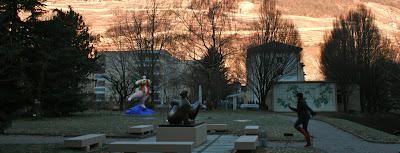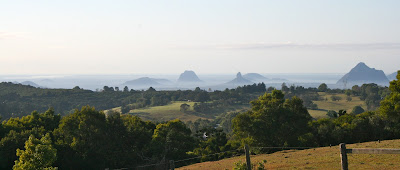 |
| Sculpture park at Fondation Pierre Gianadda, Martigny |
The Alfa 147 was a bit restless this week so Jo and I thought she might be a bit homesick. Milan is about three and a half hours drive from Lausanne which is a bit much for a day trip, so we settled for driving her through the Grand-St-Bernard tunnel to the northern Italy ski town of Aosta via Martigny Switzerland.
Martigny has an interesting history. It is located about fifty kilometres east of Lausanne in a valley where the Swiss, French and Italian Alps all meet. The town is one of the oldest in Switzerland, established by the wandering Romans in 50 B.C. It still has an intact amphitheatre and wall ruins from those early times.
Two good things about Martigny’s location is the ease of which you can get to the adjoining ski fields and it’s close proximity to France and Italy. One of the not so good things is that in winter the sun does not touch the streets or rooftops of the town and at nine a.m. in the middle of winter it is way past cold. That is why we could thank God yesterday for providing a warm cosy coffee shop that we could sit in and watch the world, according to the people of Martigny, go by from until the local art galleries opened.
And that is the third even gooder thing about Martigny (yes and I know there is the Saint Bernard Dog Museum with real live fluff bundles of SB’s and the Rhone River flows by and the vineyards). But before I go there, did you know that they use Saint Bernard dogs and their puppies in Switzerland as part of their palliative care in aged care and hospice facilities? Pretty cool idea don’t you think?
The Fondation Pierre Gianadda in Martigny is a must see for art lovers of all ages if visiting the Lausanne area. It is a gallery of exception, with a star studded line-up of the who’s who of the contemporary art world. Contemporary in this context being the1800-1970 era of European artists. You are talking Monet (We saw the Nymphs), Vincent, Cezanne, Picasso, Toulouse-Latrec, Renoir, Sam Szafran, Pissaro and the list goes on. The top floor of the gallery is dedicated to artifacts from the original Roman settlement that have been found in various digs and kept in this little town (pop. 15000) as a permanent historical reminder of what has been before. The pottery, sculptures and and silver work is pretty amazing and an interesting snapshot of how life was once lived in this little town.
In the basement floor of the Fondation Pierre Gianadda gallery Jo stumbled upon a sign that said ‘Automobile Musee’. What a great little find that sign was. We followed the sign to find a huge cavern full of every thing from a 1912 T Model Ford to a 1936 Rolls Royce Silver Ghost (it was silver at least), Bugattis and just about every European car in between. All pristinely restored to their original glory, they meekly and patiently wait to be admired. I am not sure why they are in the bomb shelter but anywhere else in the world they would have a museum of their own, in a prime, down town city location.
 |
| 1912 model T |
 |
| Bugatti |
 |
| Name it and it's yours |
Jo and I had been running around this amazing little gallery like two excited children for ages and we hadn’t even got to the icing on the cake. I read about the icing in the Lonely Planet guide one afternoon while waiting for Jo at the school. Out back of the gallery, in between remnant Roman village walls and lakes is a very groovy sculpture park. With sculptures I am talking Henry Moore, Rodin (The Kiss), Miro, Niki de Saint Phalle and other names I cannot remember. But how fun is it to amble through a natural garden filled with art work that is usually reserved for art books. I won’t mention too much about how challenging it was to take photos in the shade with frozen lakes and minus eleven degrees or that Jo and I were the only people running around in the sculpture park at this time of day. But that is the beauty of being Australian I guess. We tend to do our own thing even if that means we get frost bite doing it.
 |
| Entrance to the park |
 |
| Jo with a Henry Moore's 'Reclining nude' |
 |
| 'Reclining nude' - another angle |
 |
| Jo with a little NZ friend she met |
 |
| Niki de Saint Phalle's - Bathers |
 |
| Very cold water |
 |
| Any ideas? |
We left the gallery and once the Alfa got a sniff of the Italian Alps we were on auto pilot. The mountain road wound it’s way up to 1200 metres, past Verbier and then peaking out at around 1800 metres as we drove through the six kilometere long, Grand-St-Bernard tunnel into Italy. When the Alfa set it’s headlights on the distance slopes of The Matterhorn all we could do was hope that she didn’t decide to take any short cuts on our journey down the other side to the northern Italy town of Aosta.
Aosta is another ancient Roman settlement dating back to 25 B.C. Originally it was a retirement village for soldiers but then became an important military position and a military outpost was established there. Much of the original wall and many significant buildings are still in place and the town has been built around this architecture to preserve the region’s history and heritage. Now, back in Queensland the government would have stepped in years ago and had the Deen Brothers knock the old things down. There is even a hole in the wall where you can walk through to the other side and explore it’s perimeter back into the old village part of the town.
We found a cute little restaurant and when in Italy did the right thing and had spaghetti (I had bolognaise, Jo the pesto) crusty bread rolls and Lavazza coffee. The Lavazza reminded me of home. We spent the afternoon wandering the old buildings. As chance always has it we stumbled on a contemporary art exhibition in a 1000 year old college building which had some interesting pieces (but no photos allowed). After the shops opened from siesta at three-thirty we did a bit of cool sale retail at prices we could afford (one thing we cannot do in Switzerland) and soaked up the relaxed, laughter filled atmosphere of a northern Italian town.
 The drive home was as interesting and reflective as the day had been. The little Alfa 147 gurgled and grunted it’s way over the mountains, guided by the fading light reflected from the snow, more than content with the visit to her home soil and the opportunity to test her 1.6 litre, twin spark motor on some pretty interesting gradient and bends.
The drive home was as interesting and reflective as the day had been. The little Alfa 147 gurgled and grunted it’s way over the mountains, guided by the fading light reflected from the snow, more than content with the visit to her home soil and the opportunity to test her 1.6 litre, twin spark motor on some pretty interesting gradient and bends.
Life can be so full of beauty and simplicity if you let it be that way.
 |
| A very cold one |
 |
| Roman wall at Aosta - 12 B.C. |
 |
| All along the watchtower |
 |
| Tree sculpture in Aosta |
 |
College 1000 A.D.
|
 |
| Contemporary art poster in Aosta |
 |
The streets of Aosta
|
 |
| Church in Aosta - 1400 A. D. |
 |
| Look through any window |
 |
| Time to go home |











 The drive home was as interesting and reflective as the day had been. The little Alfa 147 gurgled and grunted it’s way over the mountains, guided by the fading light reflected from the snow, more than content with the visit to her home soil and the opportunity to test her 1.6 litre, twin spark motor on some pretty interesting gradient and bends.
The drive home was as interesting and reflective as the day had been. The little Alfa 147 gurgled and grunted it’s way over the mountains, guided by the fading light reflected from the snow, more than content with the visit to her home soil and the opportunity to test her 1.6 litre, twin spark motor on some pretty interesting gradient and bends.














Comments
Post a Comment